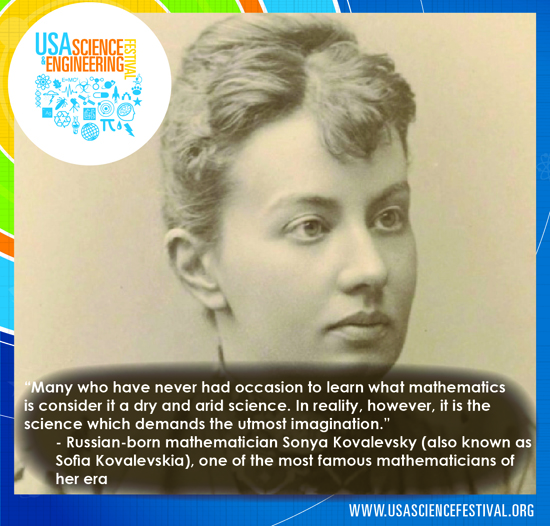Sonya Kovalevsky – Russian-born Mathematician
One of the world's best mathematicians of her era; established first major result in general theory of partial differential equations; first modern European woman appointed to full professorship; advocate of women's rights
Sonya Kovalevsky (also known as Sofia Kowalevski) was born in Russia in 1850 and became a noted mathematician in spite of a father who "had a horror of learned women," according to historical accounts. As a young woman, she could study math and physics only in secret. She married a man she did not love just to get away from her father and obtain a formal education.
She grew up a member of Russia's privileged social class. Her father was a military officer and a land holder; her mother, the granddaughter of a famous Russian astronomer, was an accomplished musician. The family lived comfortably on a country estate, where Sonya, her sister and brother were brought up by a nanny until their education was taken over by governesses and private tutors.
By the age of thirteen Sonya showed an unusual ability and enthusiasm for algebra and geometry. But her father believed that there was no need nor place for learned women, so he put a stop to further mathematical instruction. Secretly, Sonya borrowed an algebra book from one of her tutors and continued to study "under the covers" at night. About a year later a neighbor, who was a professor of science at a nearby school, gave the family a copy of an elementary physics book he'd written. When Sonya tried to read the section on optics, she bumped into trigonometry, a subject she had never heard of. To make sense of some of the derivations, she substituted "a chord for the mysterious sine," and everything worked for small angles.
The neighbor-professor was so impressed that Sonya had independently rediscovered the method by which the concept of sine had developed historically, that he tried to persuade Sonya's father to arrange serious training in mathematics for her. It took her father four years to agree to let her take private lessons in analytic geometry and calculus in St. Petersburg. She mastered these subjects quickly over one winter, much to the astonishment of her professor.
Why She's Important: She was the first major Russian female mathematician, responsible for important original contributions to analysis, differential equations and mechanics, and the first woman appointed to a full professorship in Northern Europe. She was also one of the first women to work for a scientific journal as an editor.
Sonya was not only a great mathematician, but also a writer and advocate of women's rights in the 19th century. It was her struggle to obtain the best education available which began to open doors at universities to women. In addition, her ground-breaking work in mathematics made her male counterparts reconsider their archaic notions of women's inferiority to men in such scientific arenas.
But before conquering these frontiers, she had to overcome personal challenges in her own family. For example, as a young woman, she wanted desperately to pursue a career as a doctor or chemist ("to be of use"), her family would not allow their single daughters to go abroad. So in 1868 Sonya and her older sister arranged "fictitious marriages", or marriages of convenience to radical compatriots. Sonya married a promising young paleontologist, Vladimir Kovalevsky, who would contribute to the substantiation of Darwin's new and controversial theory of evolution, and (although not in love with him) moved to Heidelberg, Germany to study science and mathematics.
After two years of mathematical studies at Heidelberg under such teachers as Hermann von Helmholtz, Gustav Kirchhoff and Robert Bunsen, she moved to Berlin, where she had to take private lessons from famous mathematician Karl Weierstrass, as the university would not even allow her to audit classes. In 1874 she presented three papers—on partial differential equations, on the dynamics of Saturn's rings and on elliptic integrals —to the University of Göttingen as her doctoral dissertation. With the support of Weierstrass, this earned her a doctorate in mathematics summa cum laude, bypassing the usual required lectures and examinations.
She thereby became the first woman in Europe to hold that degree. Her paper on partial differential equations contains what is now commonly known as the Cauchy-Kovalevski theorem, which gives conditions for the existence of solutions to a certain class of those equations.
Other Achievements: After the suicide death of her husband, Sonya was offered a teaching position at Stockholm University. After only a year, she was appointed to full professor (the first woman in Northern Europe to be named to such a post) and published her research on light refraction. In 1885 Kovalevsky was appointed chair of mechanics. Throughout her life Kovalevsky was also very interested in literature and pursued writing novels, a play, and radical political books such as A Nihilist Girl, and her memoirs.
But mathematics remained her main passion. In 1888 she won the prestigious Prix Bordin competition sponsored by the French Academy of Science. Her brilliant career was cut short, however, when she died on February 10, 1891, of pneumonia at age 41 in Sweden.
